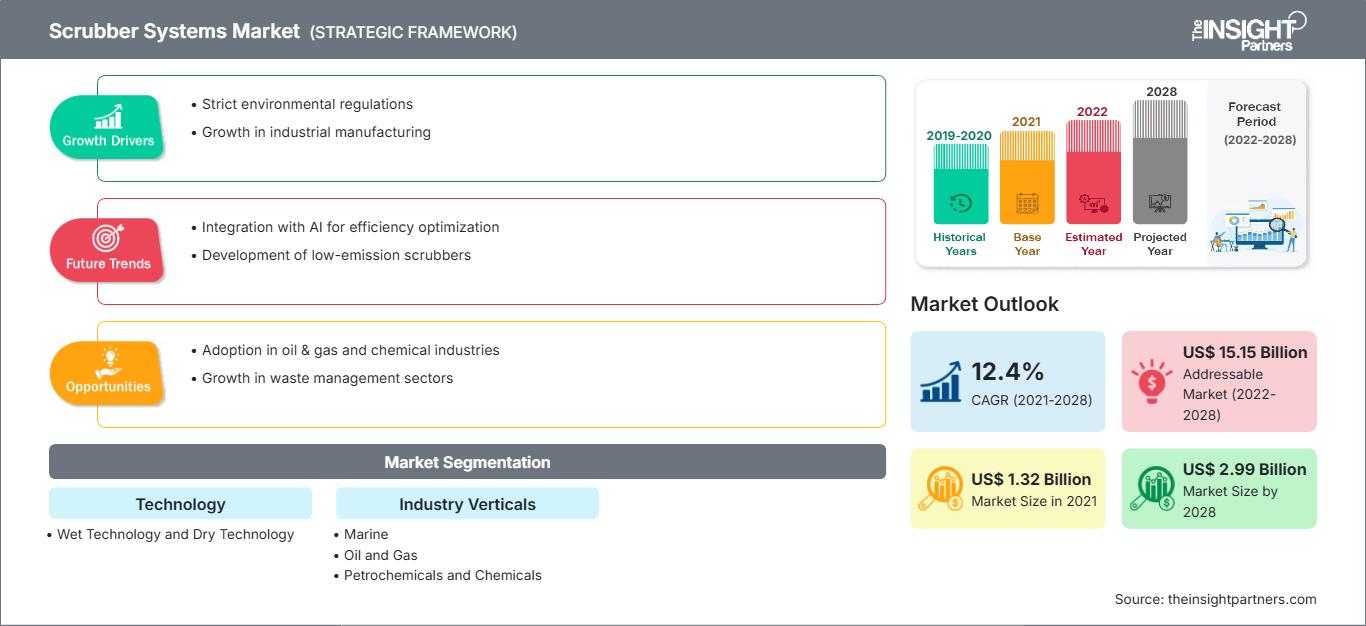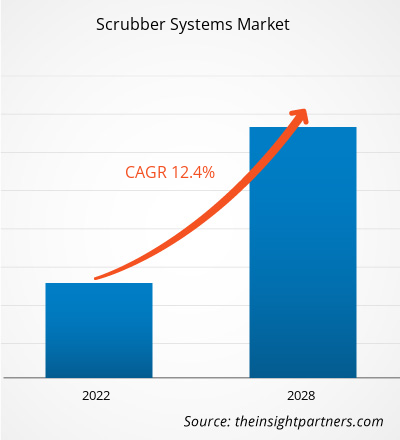Il mercato dei sistemi di lavaggio è stato valutato a 1.316,0 milioni di dollari nel 2021 e si prevede che raggiungerà i 2.989,2 milioni di dollari entro il 2028; si prevede una crescita a un CAGR del 12,4% dal 2021 al 2028.
Le principali industrie manifatturiere come cemento, vetro, chimica e petrolchimica, agroalimentare e farmaceutica sono note per le emissioni di gas nocivi. Pertanto, le severe normative ambientali imposte a questi settori stanno trainando il mercato. Ad esempio, l'industria del cemento è una delle principali industrie inquinanti in quanto rilascia particolato di biossido di azoto (NO2) e anidride solforosa (SO2) durante la produzione. Inoltre, l'aumento degli scambi commerciali internazionali attraverso le rotte marittime e l'aumento delle attività ricreative stanno stimolando la crescita del mercato dei sistemi di lavaggio. L'aumento del commercio marittimo globale può essere attribuito ai suoi bassi costi di trasporto e alla continua crescita della domanda globale di beni e prodotti petroliferi. Inoltre, la crescente partecipazione ad attività ricreative come crociere e viaggi internazionali sta incrementando l'utilizzo di navi da crociera e, di conseguenza, alimentando la crescita del mercato dei sistemi di depurazione.
Impatto della pandemia di COVID-19 sul mercato dei sistemi di depurazione
L'improvvisa epidemia di COVID-19 ha avuto un impatto negativo significativo sulla domanda del settore dei sistemi di depurazione a seguito della pandemia globale. Nell'agosto 2020, Yara Marine Technologies, uno dei principali attori nel settore degli scrubber marini, ha distolto la sua attenzione dal mercato a causa del COVID-19 e dei bassi prezzi del petrolio. Il responsabile dell'innovazione dell'azienda ha dichiarato di avere riposto grandi speranze nel 2020 per i sistemi di depurazione, ma il COVID-19 ha cambiato tutto. Tuttavia, il mercato ha assistito a un aumento della domanda a partire dal terzo trimestre, poiché diversi governi hanno introdotto normative rigorose per mantenere l'aria pulita. I sistemi di depurazione dell'aria svolgono un ruolo fondamentale nella rimozione delle particelle pericolose dai gas di scarico, aiutando il mercato a riprendere slancio.
Personalizza questo rapporto in base alle tue esigenze
Potrai personalizzare gratuitamente qualsiasi rapporto, comprese parti di questo rapporto, o analisi a livello di paese, pacchetto dati Excel, oltre a usufruire di grandi offerte e sconti per start-up e università
Mercato dei sistemi di depurazione: Approfondimenti strategici

- Ottieni le principali tendenze chiave del mercato di questo rapporto.Questo campione GRATUITO includerà l'analisi dei dati, che vanno dalle tendenze di mercato alle stime e alle previsioni.
Approfondimenti di mercato - Aumento del mercato dei sistemi di depurazione nel commercio marittimo globale e nelle attività ricreative
Potrai personalizzare gratuitamente qualsiasi rapporto, comprese parti di questo rapporto, o analisi a livello di paese, pacchetto dati Excel, oltre a usufruire di grandi offerte e sconti per start-up e università
Mercato dei sistemi di depurazione: Approfondimenti strategici

- Ottieni le principali tendenze chiave del mercato di questo rapporto.Questo campione GRATUITO includerà l'analisi dei dati, che vanno dalle tendenze di mercato alle stime e alle previsioni.
L'aumento del commercio internazionale attraverso le rotte marittime e l'aumento delle attività ricreative stanno stimolando la crescita del mercato dei sistemi di depurazione. L'aumento del commercio marittimo globale può essere attribuito ai costi di trasporto ridotti e alla domanda globale in continua crescita di beni e prodotti petroliferi. Inoltre, la crescente partecipazione ad attività ricreative come crociere e viaggi internazionali sta aumentando l'uso di navi marittime e, di conseguenza, alimenta la crescita del mercato dei sistemi di depurazione. L'aumento delle attività ricreative può essere attribuito all'aumento del reddito pro capite dei consumatori. Pertanto, l'aumento delle emissioni di zolfo dalle navi, dovuto al fiorente commercio globale, e l'intensificazione del trasporto marittimo nelle economie in via di sviluppo e sviluppate stanno dando impulso all'installazione di sistemi di depurazione.
Approfondimenti basati sulla tecnologia
In base alla tecnologia, il mercato dei sistemi di depurazione è segmentato in tecnologia a umido e tecnologia a secco. Il segmento della tecnologia a umido ha detenuto una quota di mercato maggiore nel 2021.
Gli operatori che operano nel mercato dei sistemi di lavaggio si concentrano principalmente sullo sviluppo di prodotti avanzati ed efficienti.
- A luglio 2021, Babcock & Wilcox Environmental ha annunciato che avrebbe sostenuto la richiesta dell'Amager Resource Center per la costruzione di un impianto avanzato di cattura dell'anidride carbonica presso l'impianto di termovalorizzazione di Amager-Bakke (Copenhill) di ARC a Copenaghen, in Danimarca, per oltre 140 milioni di dollari.
- A settembre 2021, DuPont Clean Technologies ha introdotto un'innovativa e avanzata soluzione di soppressione del pennacchio di vapore per i suoi scrubber MECS DynaWave nelle applicazioni delle unità di recupero dello zolfo (SRU). Sennuba fornisce un controllo affidabile della corrosione e la soppressione del pennacchio nel sistema di lavaggio, con un rischio minimo di intasamento.
Approfondimenti regionali sul mercato dei sistemi di depurazione
Le tendenze regionali e i fattori che influenzano il mercato dei sistemi di lavaggio durante il periodo di previsione sono stati ampiamente spiegati dagli analisti di The Insight Partners. Questa sezione illustra anche i segmenti e la geografia del mercato dei sistemi di lavaggio in Nord America, Europa, Asia-Pacifico, Medio Oriente e Africa, America Meridionale e Centrale.
Ambito del rapporto di mercato sui sistemi di depurazione
| Attributo del rapporto | Dettagli |
|---|---|
| Dimensioni del mercato in 2021 | US$ 1.32 Billion |
| Dimensioni del mercato per 2028 | US$ 2.99 Billion |
| CAGR globale (2021 - 2028) | 12.4% |
| Dati storici | 2019-2020 |
| Periodo di previsione | 2022-2028 |
| Segmenti coperti |
By Tecnologia
|
| Regioni e paesi coperti | Nord America
|
| Leader di mercato e profili aziendali chiave |
|
Densità degli operatori del mercato dei sistemi di depurazione: comprendere il suo impatto sulle dinamiche aziendali
Il mercato dei sistemi di depurazione è in rapida crescita, trainato dalla crescente domanda degli utenti finali, dovuta a fattori quali l'evoluzione delle preferenze dei consumatori, i progressi tecnologici e una maggiore consapevolezza dei vantaggi del prodotto. Con l'aumento della domanda, le aziende stanno ampliando la propria offerta, innovando per soddisfare le esigenze dei consumatori e sfruttando le tendenze emergenti, alimentando ulteriormente la crescita del mercato.

- Ottieni il Mercato dei sistemi di depurazione Panoramica dei principali attori chiave
- Tecnologia a umido
- Tecnologia a secco
Mercato dei sistemi di lavaggio - per settori verticali
- Marina
- Petrolchimica e prodotti chimici
- Alimenti e agricoltura
- Trattamento delle acque reflue
- Sanità
- Altri
Mercato dei sistemi di lavaggio - per tecnologia
- Marina
- Petrolchimica e prodotti chimici
- Alimentare e agricoltura
- Trattamento delle acque reflue
- Sanità
- Altri
Mercato dei sistemi di lavaggio - per tecnologia
- Marina
- Petrolchimica e prodotti chimici ...Petrolchimica e prodotti chimici
- Petrolchimica e prodotti chimici
- Petrolchimica e prodotti chimici
- Petrolchimica e prodotti chimici
- Petrolchimica e prodotti chimici
- Petrolchimica e prodotti chimici
- Petrolchimica e prodotti chimici
- Petrolchimica e prodotti chimici
- Petrolchimica e prodotti chimici
- Petrolchimica e prodotti chimici
- Petrolchimica e prodotti chimici
- Petrolchimica e prodotti chimici
- Petrolchimica e prodotti chimici
- Petrolchi per area geografica
- Nord America
- Stati Uniti
- Canada
- Messico
- Europa
- Germania
- Francia
- Italia
- Regno Unito
- Russia
- Resto d'Europa
- Asia Pacifico (APAC)
- Cina
- India
- Giappone
- Corea del Sud
- Thailandia
- Resto dell'APAC
- Medio Oriente e Stati Uniti. Africa
- Sudafrica
- Resto del MEA
- Sud America
- Brasile
- Argentina
- Resto del SAM
Mercato dei sistemi di lavaggio - Profili aziendali
- Babcock & Wilcox Enterprises, Inc
- Alfa Laval
- DuPont de Nemours, Inc.
- FUJI ELECTRIC CO., LTD.
- GEA Group AG
- Wärtsilä Corporation
- Hamon
- Yara Marine Technologies
- Verantis Environmental Solutions Group
- CECO Environmental
- Analisi storica (2 anni), anno base, previsione (7 anni) con CAGR
- Analisi PEST e SWOT
- Valore/volume delle dimensioni del mercato - Globale, Regionale, Nazionale
- Industria e panorama competitivo
- Set di dati Excel
Report recenti
Testimonianze
Motivo dell'acquisto
- Processo decisionale informato
- Comprensione delle dinamiche di mercato
- Analisi competitiva
- Analisi dei clienti
- Previsioni di mercato
- Mitigazione del rischio
- Pianificazione strategica
- Giustificazione degli investimenti
- Identificazione dei mercati emergenti
- Miglioramento delle strategie di marketing
- Aumento dell'efficienza operativa
- Allineamento alle tendenze normative
- Nord America




















 Ottieni un campione gratuito per - Mercato dei sistemi di depurazione
Ottieni un campione gratuito per - Mercato dei sistemi di depurazione